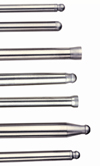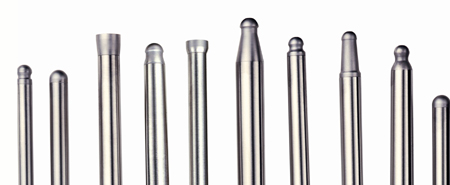Pushrods - one-piece or three-piece?
 When we look at the offerings from the major pushrod manufacturers, we see that there are many who offer assembled pushrods made from multiple pieces - usually three - with a typical race pushrod consisting of a long, slender central section combined with two ends which are assembled into the central section. Dieter van der Put, in his recent article looked at a method of producing a single-piece pushrod from three pieces, using the process of friction welding.
When we look at the offerings from the major pushrod manufacturers, we see that there are many who offer assembled pushrods made from multiple pieces - usually three - with a typical race pushrod consisting of a long, slender central section combined with two ends which are assembled into the central section. Dieter van der Put, in his recent article looked at a method of producing a single-piece pushrod from three pieces, using the process of friction welding.
So, what are the advantages of producing a rod in three pieces? Well, there are many. A primary reason is one of economics - particularly relevant in recent times.
The pushrod ends need to be hard and wear-resistant, being durable without causing damage to their adjacent parts during sliding contact. The ends are quite often made of very hard steels, commonly tool steel, and the cost of producing complete pushrods in tool steel can be prohibitively expensive, especially given that there is no requirement for the material to resist high contact loads except at the ends of the pushrod.
The central part of the pushrod can be made from a cheaper material that simply fulfils the requirements of being sufficiently strong and stiff. Furthermore, an assembled pushrod has the advantage that the ends can be subjected to special surface treatments aimed at improving wear characteristics which may not suit the centre section, or which would prove an expensive option if carried out over the whole length of the pushrod.
A single design of centre section can be fitted with any one of a large selection of ends, and these can be different at each end, compatible with the mating parts (lifter and rocker). A selection of different pushrod end designs is shown in the photo here.
This means that a special-purpose pushrod, compatible with components from different suppliers, can be quickly assembled without needing to resort to a bespoke design. Depending on the design of the ends and their method of fitting, it may be possible to exchange end pieces that show signs of wear. Some people choose to 'refurbish' pushrods in this manner; others choose to retire rods whose ends have become worn.

Pushrods can be assembled to the correct length quickly by holding an inventory of different lengths of centre sections to which the ends are fitted. Again, this is economical compared to holding a wide stock of solid single-piece pushrods.
Having made the economic case, there are a number of high-profile and high-budget engineering-led race engine suppliers who use three-piece pushrods - NASCAR Sprint Cup included - so the engineering case for this type of construction remains strong.
There are others for whom the economic considerations are not so strong, and who see benefit in single-piece rods, machined entirely from a material with the correct specifications to resist wear in the highly loaded contacts at each end, although they often come at a significant premium.
Single-piece rods cannot be assembled wrongly, however, nor do they suffer from the assembly becoming loose over time, and compared to a three-piece rod of the same geometry they should be slightly stiffer. Since the advent of widespread 'Spintron' testing, pushrod stiffness has been found to be very important to proper valve control, and NASCAR Cup engine builders and others have moved to much stiffer designs in recent years.
Fig. 1 - Part of a wide range of pushrod ends fitted to 'standard' centre sections (Courtesy of Manton Pushrods)
Written by Wayne Ward